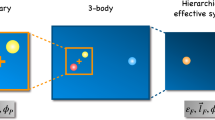Abstract
The flux-based statistical theory of the non-hierarchical three-body system predicts that the chaotic outcome distribution reduces to the chaotic emissivity function times a known function, the asymptotic flux. Here, we measure the chaotic emissivity function (or equivalently, the absorptivity) through simulations. More precisely, we follow millions of scattering events only up to the point when it can be decided whether the scattering is regular or chaotic. In this way, we measure a trivariate absorptivity function. Using it, we determine the flux-based prediction for the chaotic outcome distribution over both binary binding energy and angular momentum, and we find good agreement with the measured distribution. This constitutes a detailed confirmation of the flux-based theory and demonstrates a considerable reduction in computation to determine the chaotic outcome distribution.








Similar content being viewed by others
Data availability
The tsunami code, the initial conditions and the simulation data underlying this article will be shared on reasonable request to the corresponding author.
References
Agekyan, T.A., Anosova, Z.P.: A study of the dynamics of triple systems by means of statistical sampling. Astronomicheskii Zhurnal 44, 1261 (1967). https://ui.adsabs.harvard.edu/abs/1967AZh....44.1261A
Blanchet, L.: Gravitational radiation from post-Newtonian sources and inspiralling compact binaries. Living Rev. Relativ. 17, 1–187 (2014). https://doi.org/10.12942/lrr-2014-2
Dandekar, Y., Kol, B., Lederer, L., Mazumdar, S.: Regularized phase-space volume for the three-body problem. Celest. Mech. Dyn. Astron. 134, 55 (2022). https://doi.org/10.1007/s10569-022-10108-1
Foreman-Mackey, D., Hogg, D.W., Lang, D., Goodman, J.: emcee: The MCMC hammer. Publ. Astron. Soc. Pacific 125, 306 (2013). https://doi.org/10.1086/670067
Ginat, Y.B., Perets, H.B.: Analytical statistical approximate solution of dissipative and nondissipative binary-single stellar encounters. Phys. Rev. X 11, 031020 (2021). https://doi.org/10.1103/PhysRevX.11.031020
Ginat, Y.B., Perets, H.B.: Analytic modelling of binary-single encounters: non-thermal eccentricity distribution and gravitational-wave source formation. MNRAS 519, L15 (2023). https://doi.org/10.1093/mnrasl/slac145
Hunter, J.D.: Matplotlib: a 2D graphics environment. Comput. Sci. Eng. 9, 90 (2007). https://doi.org/10.1109/MCSE.2007.55
Hut, P.: Tidal evolution in close binary systems. A &A 99, 126 (1981)
Kluyver, T., et al.: In: Loizides F., Scmidt B., Jupyter Notebooks : a publishing format for reproducible computational workflows eds, Positioning and Power in Academic Publishing: Players, Agents and Agendas. IOS Press, pp 87–90 (2016). https://eprints.soton.ac.uk/403913/
Kol, B.: Flux-based statistical prediction of three-body outcomes. Celest. Mech. Dyn. Astron. 133, 17 (2021). https://doi.org/10.1007/s10569-021-10015-x
Kol, B.: Natural dynamical reduction of the three-body Celest. Mech. Dyn. Astron. 135, 29 (2023). https://doi.org/10.1007/s10569-023-10144-5
Leigh, N.W.C., Stone, N.C., Webb, J.J., Lyra, W.: The thermodynamics of stellar multiplicity: an analytic model for the dynamical evolution of binary star populations in dense stellar environments due to single-binary interactions. MNRAS 517, 3838 (2022). https://doi.org/10.1093/mnras/stac2907
Manwadkar, V., Trani, A.A., Leigh, N.W.C.: Chaos and Lévy flights in the three-body problem. MNRAS 497, 3694 (2020). https://doi.org/10.1093/mnras/staa1722
Manwadkar, V., Kol, B., Trani, A.A., Leigh, N.W.C.: Testing the flux-based statistical prediction of the three-body problem. MNRAS 506, 692 (2021). https://doi.org/10.1093/mnras/stab1689
McMillan, S.L.W., Hut, P.: Binary-single-star scattering. automatic determination of interaction cross sections. APJ VI 467, 348 (1996). https://doi.org/10.1086/177610
Mikkola, S., Aarseth, S.J.: An implementation of N-body chain regularization. Celest. Mech. Dyn. Astron. 57, 439 (1993). https://doi.org/10.1007/BF00695714
Mikkola, S., Tanikawa, K.: Explicit symplectic algorithms for time-transformed Hamiltonians. Celest. Mech. Dyn. Astron. 74, 287 (1999a). https://doi.org/10.1023/A:1008368322547
Mikkola, S., Tanikawa, K.: Algorithmic regularization of the few-body problem. MNRAS 310, 745 (1999b). https://doi.org/10.1046/j.1365-8711.1999.02982.x
Monaghan, J.J.: A statistical theory of the disruption of three-body systems—I. Low angular momentum. MNRAS 176, 63 (1976). https://doi.org/10.1093/mnras/176.1.63
Poincaré, H.: Sur le problème des trois corps et les équations de la dynamique (The Three-Body Problem and the Equations of Dynamics). Acta Math 13, 5 (1890). https://doi.org/10.1007/978-3-319-52899-1
Samsing, J., Leigh, N.W.C., Trani, A.A.: Implementing tidal and gravitational wave energy losses in few-body codes: a fast and easy drag force model. MNRAS 481, 5436 (2018). https://doi.org/10.1093/mnras/sty2247
Stoer, J., Bulirsch, R., Mikulska, M.: Wstęp do Metod Numerycznych Wstęp do Metod Numerycznych. Państwowe Wydaw, Naukowe (1980)
Stone, N.C., Leigh, N.W.C.: A statistical solution to the chaotic, non-hierarchical three-body problem. Nature 576, 406 (2019). https://doi.org/10.1038/s41586-019-1833-8
Trani, A.A., Spera, M.: Modeling gravitational few-body problems with tsunami and okinami. IAU Sympos. 362, 404 (2023). https://doi.org/10.1017/S1743921322001818
Trani, A.A., Fujii, M.S., Spera, M.: The Keplerian three-body encounter. I. Insights on the origin of the S-stars and the G-objects in the galactic center. Astrophys. J. 875, 42 (2019). https://doi.org/10.3847/1538-4357/ab0e70
Valtonen, M., Karttunen, H.: The Three-Body Problem. Cambridge University Press, Cambridge (2006)
van der Walt, S., Colbert, S.C., Varoquaux, G.: The NumPy array: a structure for efficient numerical computation. Comput. Sci. Eng. 13, 22 (2011). https://doi.org/10.1109/MCSE.2011.37
Acknowledgements
A.A.T. acknowledges support from JSPS KAKENHI Grant Number 21K13914 and from the European Union’s Horizon 2020 research and innovation program under the Marie Skłodowska-Curie grant agreement no. 847523 ‘INTERACTIONS’. BK was partially supported by the Israel Science Foundation (grant No. 1345/21). Analyses presented in this paper were greatly aided by the following free software packages: NumPy (van der Walt et al. 2011), Matplotlib (Hunter 2007), emcee (Foreman-Mackey et al. 2013) and Jupyter (Kluyver et al. 2016). This research has made extensive use of NASA’ s Astrophysics Data System and arXiv.
Author information
Authors and Affiliations
Corresponding author
Additional information
Publisher's Note
Springer Nature remains neutral with regard to jurisdictional claims in published maps and institutional affiliations.
Rights and permissions
Springer Nature or its licensor (e.g. a society or other partner) holds exclusive rights to this article under a publishing agreement with the author(s) or other rightsholder(s); author self-archiving of the accepted manuscript version of this article is solely governed by the terms of such publishing agreement and applicable law.
About this article
Cite this article
Manwadkar, V., Trani, A.A. & Kol, B. Measurement of three-body chaotic absorptivity predicts chaotic outcome distribution. Celest Mech Dyn Astron 136, 4 (2024). https://doi.org/10.1007/s10569-023-10174-z
Received:
Revised:
Accepted:
Published:
DOI: https://doi.org/10.1007/s10569-023-10174-z



